Creating a personal oasis in your backyard is more than just a trend—it’s a rewarding journey that enhances your living space and brings joy for years to come. Whether you’re just beginning your outdoor transformation or are a seasoned patio pro, a well-designed pergola can be a game-changer, offering both shade and a sense of privacy. Imagine stepping out into a serene retreat that reflects your style and meets your needs, right in your own backyard.
In this article, we’ll explore 15 inspiring pergola designs that cater to a range of preferences and requirements, from minimalist structures to elaborate, vine-clad havens. You’ll discover how to choose the right pergola to fit your space, elevate your garden’s aesthetic, and provide practical solutions for sun protection and seclusion. Get ready to transform your outdoor area into a stunning extension of your home, where relaxation and entertainment can flourish under the perfect pergola.
Choosing the Right Pergola Style
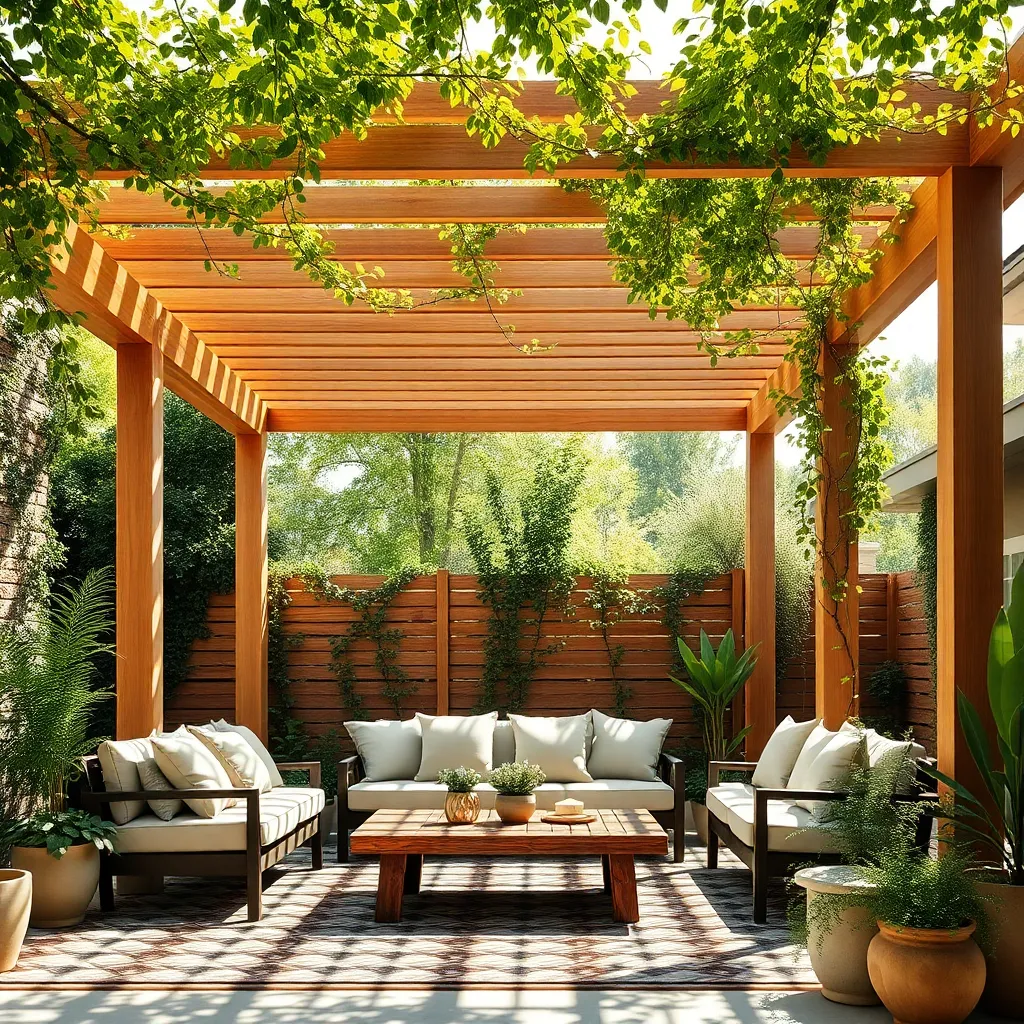
When choosing the right pergola style, consider the functionality and aesthetics that best suit your backyard environment. For beginners, a basic wooden pergola with pressure-treated pine can offer a rustic charm while being cost-effective and easy to work with. If you’re seeking durability and a modern look, consider metal options like aluminum or steel, which provide sleek lines and low maintenance. Ensure your pergola complements existing outdoor elements such as patios or garden paths to create a cohesive space.
For those looking to add a touch of sophistication, explore intricate design elements like lattice roofs or curved beams that can enhance both shade and style. Advanced builders might experiment with integrated lighting or retractable canopies for adjustable shade and ambiance. Pay attention to scale; a standard pergola typically measures about 8 to 12 feet in height and 12 to 16 feet in width, but customizing dimensions to fit your specific space will optimize both form and function. Consider using cedar or redwood for their natural resistance to decay and insects, ensuring longevity and minimal upkeep.
Incorporating Adjustable Slats for Shade
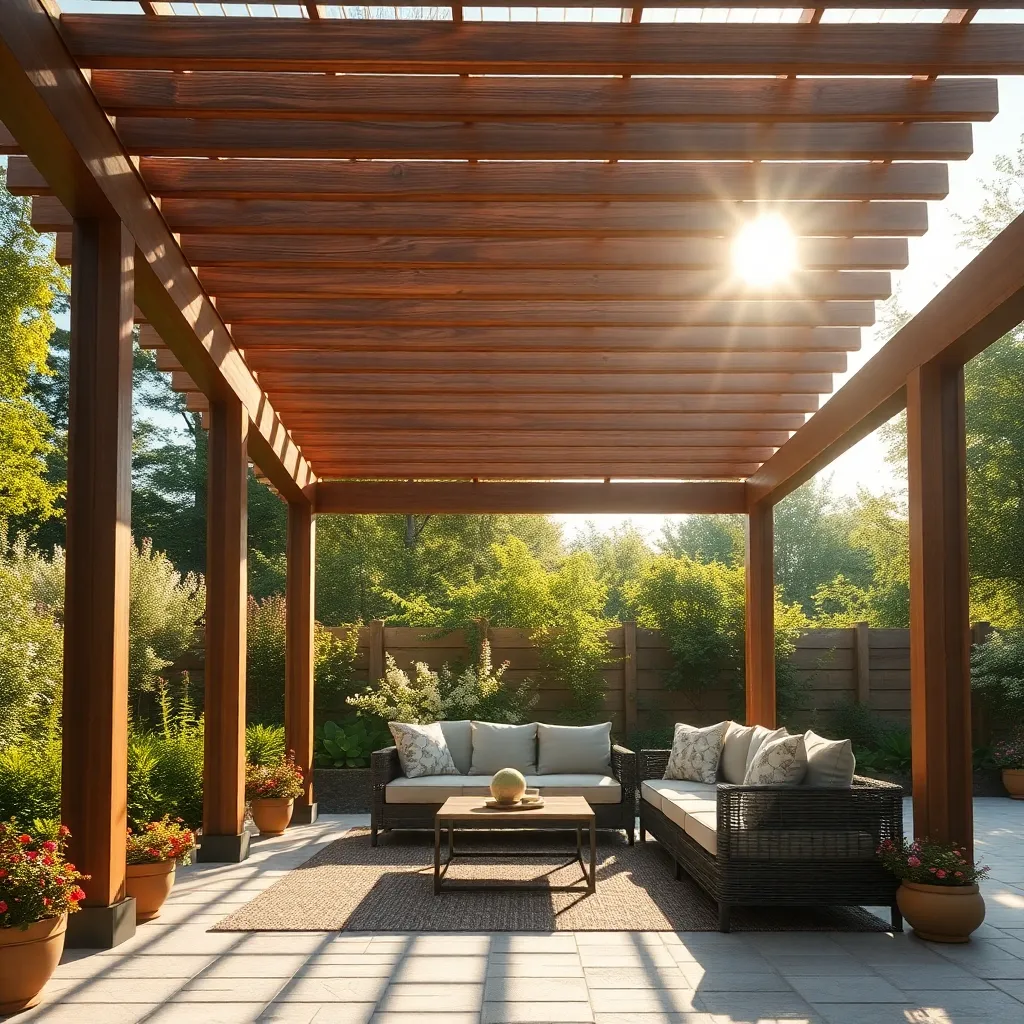
Incorporating adjustable slats into your pergola design offers a flexible solution for managing sunlight and enhancing privacy. Begin by selecting durable materials such as aluminum or treated wood, which can withstand various weather conditions. Adjustable slats let you control the amount of shade by altering their angle, providing either full sun or complete shade as needed. For DIY enthusiasts, installing a manual louver system can be a rewarding project, while motorized options offer convenience for those seeking a more automated setup.
Consider the dimensions and spacing of the slats to ensure optimal functionality; slats that are 2-3 inches wide and spaced 1-2 inches apart are commonly effective. For a seamless integration with your pergola, match the slat material and color to your existing structure. Advanced enthusiasts can explore sensors that adjust the slats automatically based on weather conditions. This feature not only enhances comfort but also extends the longevity of your outdoor furniture by protecting it from harsh sun exposure. Adjusting slats is a practical way to customize your outdoor living space, making it comfortable and inviting throughout the year.
Modern Minimalist Pergola Designs
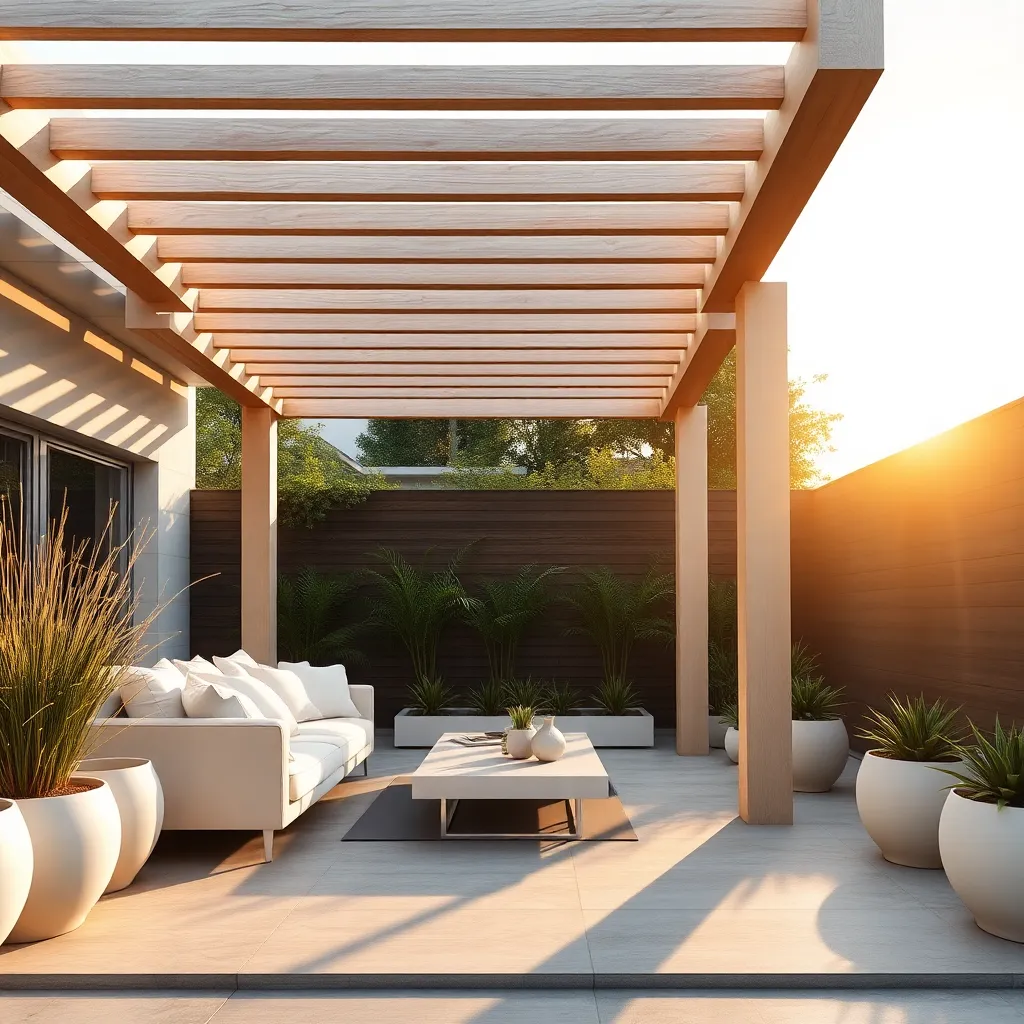
Modern minimalist pergola designs offer a sleek and sophisticated way to enhance your backyard with both shade and style. To achieve this look, consider using materials like powder-coated aluminum or sustainably sourced wood, which provide durability and a clean aesthetic. Beginners can start with a simple rectangular frame, ensuring the pergola complements the existing landscape and architecture of their home. For a more advanced approach, incorporating integrated lighting or rainproof canopies can add functionality while maintaining the minimalist appeal.
Focus on clean lines and open spaces to embody the essence of modern minimalism. Opt for neutral colors such as white, gray, or natural wood tones that blend seamlessly with the outdoor environment. When constructing, ensure the pergola’s dimensions are proportional to your outdoor space, typically allowing for a height of 8-10 feet to create an airy feel. For those looking to add a touch of luxury, consider installing a retractable roof or automated shading system, allowing you to adjust to sunlight and weather conditions effortlessly. This combination of thoughtful design and practical features ensures your pergola is both a stunning and functional addition to your backyard.
Using Vines for Natural Coverage
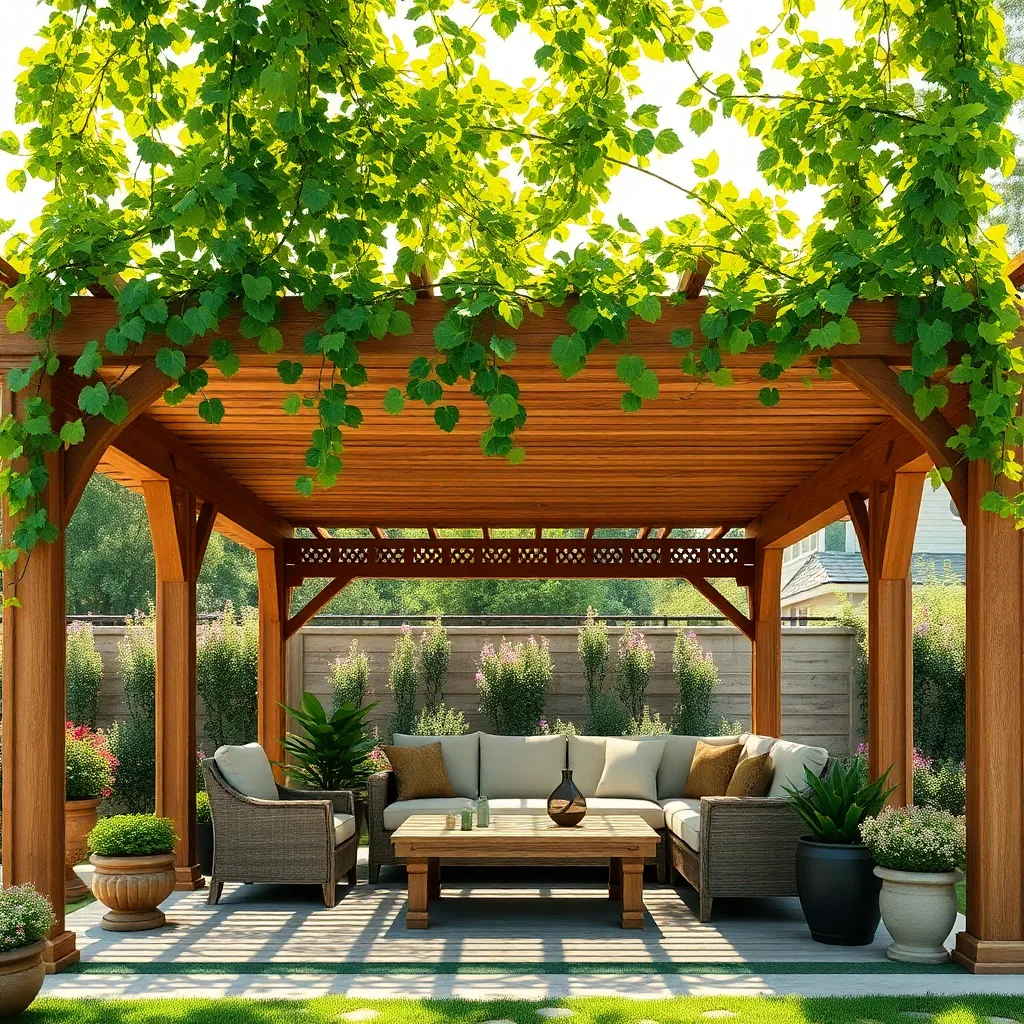
Incorporating vines into your pergola design is a fantastic way to achieve natural coverage while injecting vibrant greenery into your space. Start by choosing hardy, fast-growing vines like Clematis, Wisteria, or Virginia Creeper that can thrive in your local climate. These vines not only provide excellent shade but also add a beautiful, natural aesthetic as they wrap around the pergola’s beams. Install sturdy trellises or wire guides on your pergola to support the vines as they climb, ensuring the structure can handle the weight and growth over time.
For a more advanced approach, consider integrating a drip irrigation system to ensure your vines receive consistent moisture without the hassle of manual watering. Use weather-resistant materials like galvanized steel cables for longevity, and position them at strategic intervals to guide the growth and shape of the vines. Regular pruning will help maintain their health and prevent overgrowth, ensuring your pergola remains an attractive focal point in your backyard. With careful planning, using vines for natural coverage can transform your pergola into a lush, inviting retreat.
Enhancing Privacy with Lattice Walls
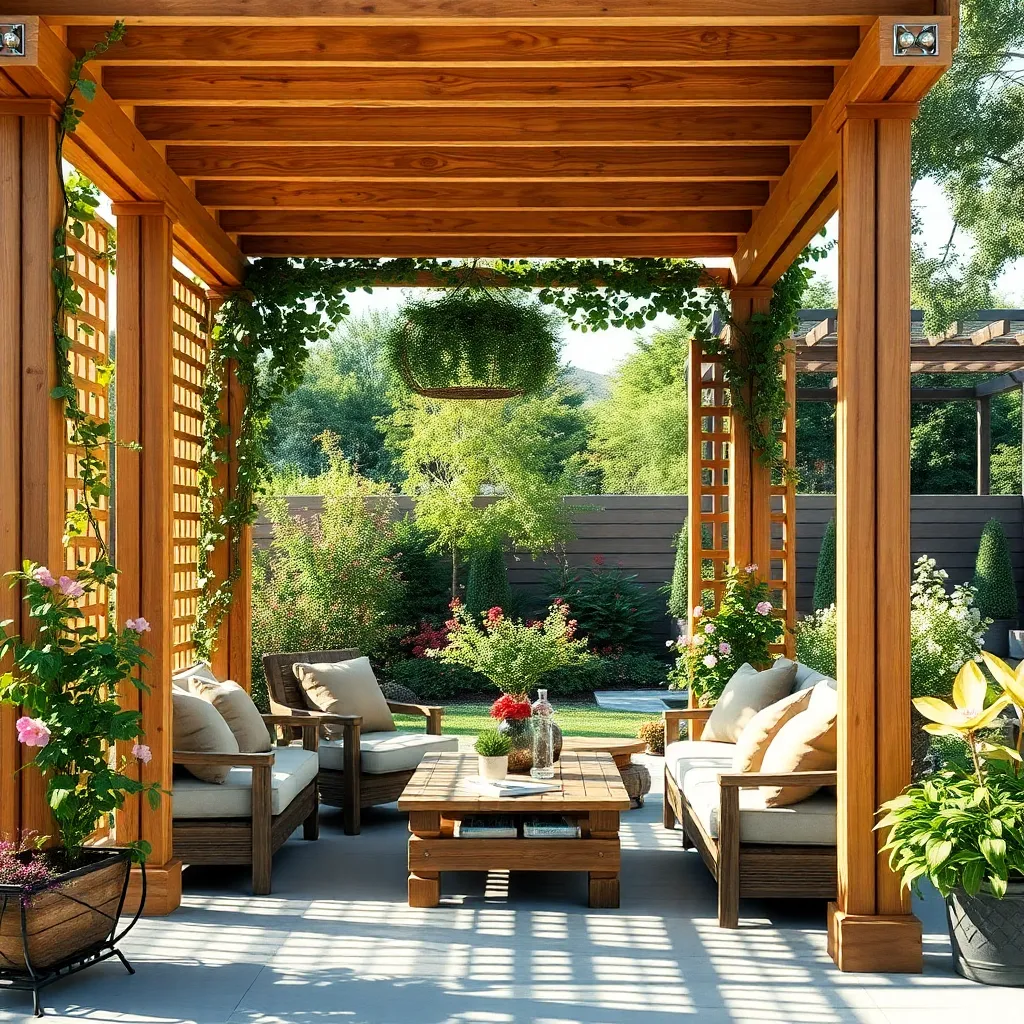
Installing lattice walls on your pergola is an excellent way to enhance privacy while maintaining an open, airy feel. Lattice panels can be easily attached to the sides of your pergola, providing a stylish barrier that blocks unwanted views. Choose from materials like wood, vinyl, or composite, each offering different levels of durability and maintenance. For those new to DIY projects, pre-made lattice panels are readily available and can be cut to size with a simple hand saw. Ensure the panels are securely fastened to the pergola frame using weather-resistant screws to withstand outdoor conditions.
For a customized touch, consider painting or staining wooden lattice panels to complement your outdoor decor. Advanced builders might opt to create custom lattice designs, like diagonal or curved patterns, for a unique flair. Pairing your lattice walls with climbing plants can further enhance privacy and add a natural element to your pergola. Fast-growing vines such as clematis or honeysuckle can quickly cover the lattice, creating a lush, green screen. For extra stability, attach lattice panels to a sturdy frame, ensuring they can support the weight of any climbing plants. These enhancements not only boost privacy but also add aesthetic value to your backyard oasis.
Rustic Wooden Pergola Ideas

For those looking to add a touch of rustic charm to their backyard, a wooden pergola can be an excellent choice. Opt for durable woods like cedar or redwood, which are naturally resistant to decay and insects. When designing your pergola, aim for a size that complements your space—typically a 10×10-foot structure works well for most backyards. Consider leaving the wood unfinished to enhance the rustic look, allowing it to weather naturally over time.
Incorporate design elements such as angled rafters or cross beams for added visual interest. Beginners might start with a simple square design, while experienced DIY enthusiasts can experiment with more intricate patterns or lattice accents. To ensure longevity, use galvanized screws and bolts, which prevent rust and maintain the pergola’s structural integrity.
- Regularly inspect your pergola for any signs of wear or insect activity.
- Apply a wood preservative every few years to extend its lifespan.
These simple steps will keep your rustic wooden pergola looking beautiful and functional for years to come.
Integrating Built-In Seating Options
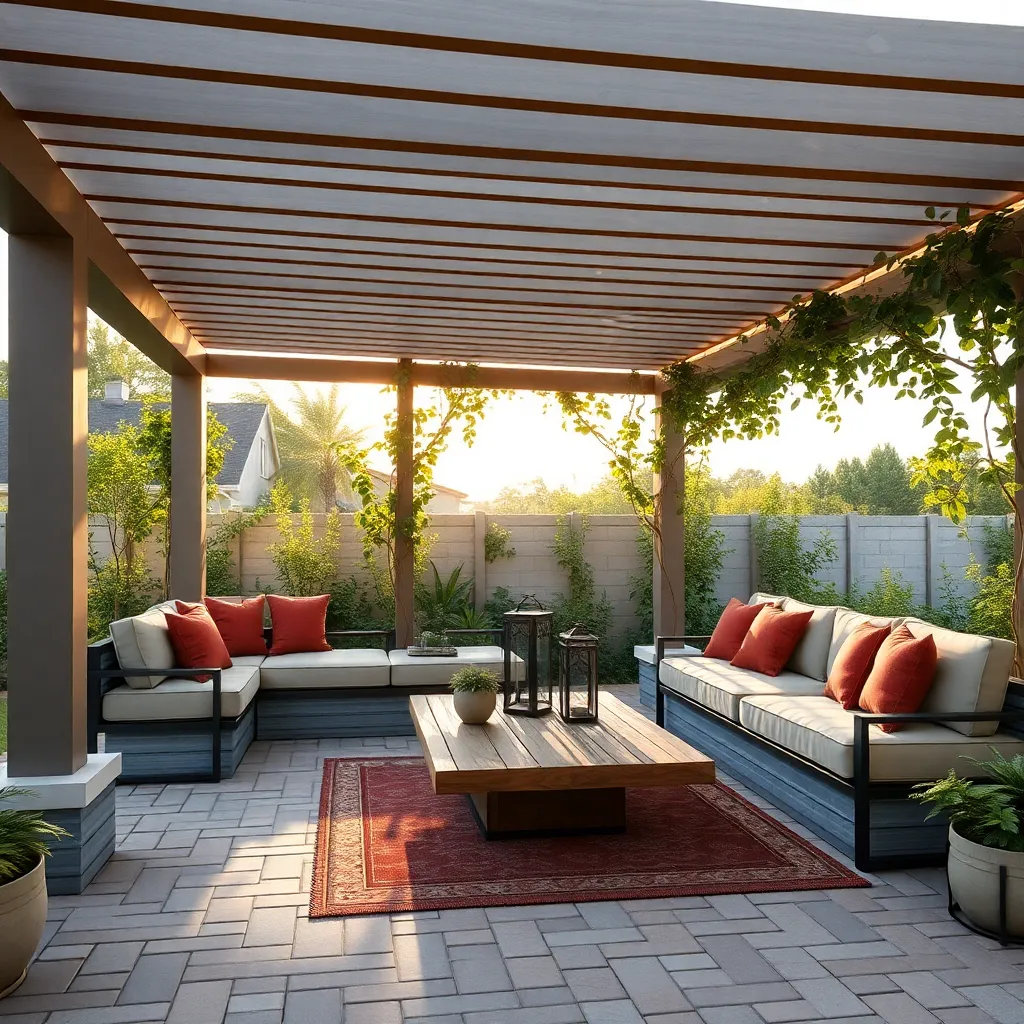
Incorporating built-in seating into your pergola design not only enhances comfort but also maximizes the use of space. Opt for materials like weather-resistant wood or composite decking for durability and style. Consider dimensions carefully; a standard bench height is about 18 inches, with a depth of 15-18 inches. For a more sophisticated touch, add cushions made from outdoor fabrics to withstand the elements.
To elevate the aesthetic and functionality, integrate storage solutions beneath the seating. This can be achieved by using hinged tops or drawers, providing a convenient place to store outdoor essentials. For those seeking an advanced project, install built-in planters at the ends of the seating to seamlessly blend nature with structure. Remember, keep the design cohesive with the pergola by matching materials and finishes.
Metal Pergolas: Sleek and Durable
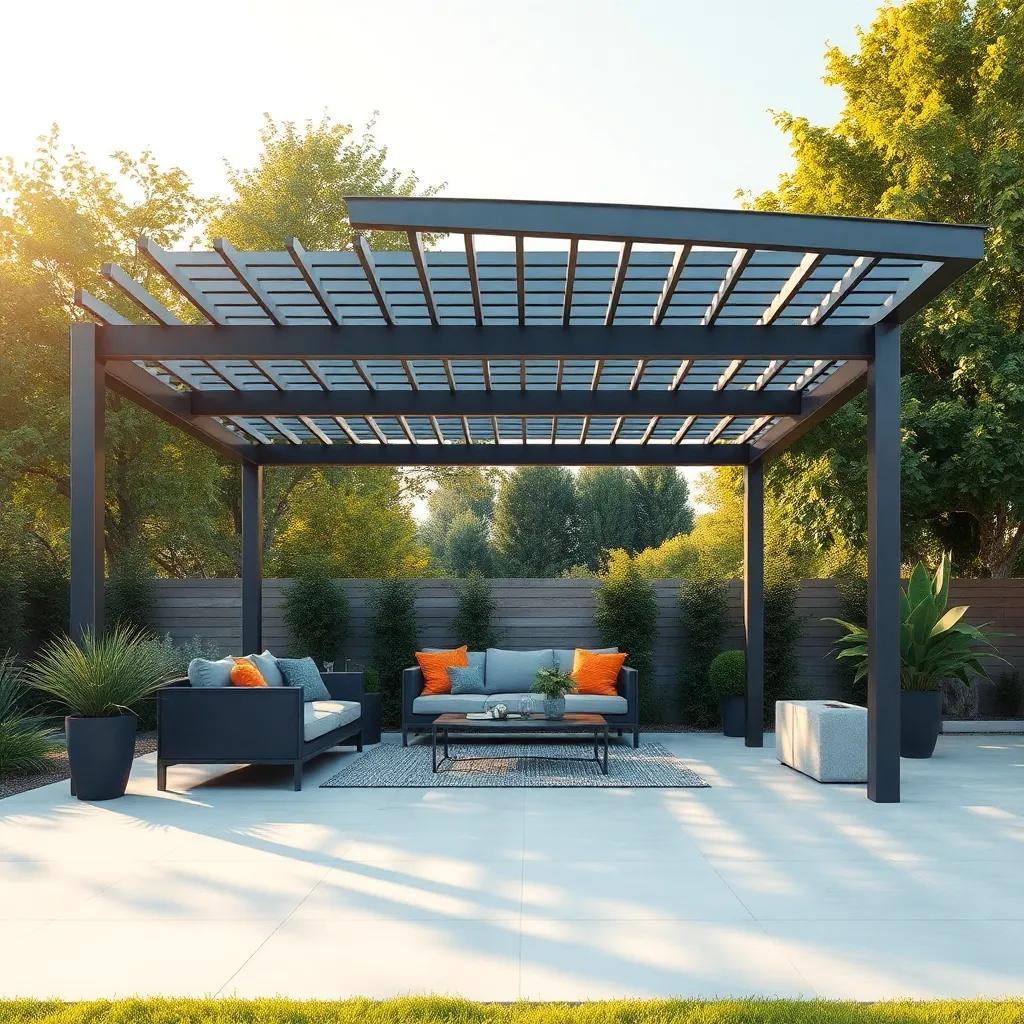
Metal pergolas offer a sleek and modern look that is both visually appealing and highly durable, making them an excellent choice for homeowners seeking a low-maintenance outdoor structure. Crafted from materials like aluminum or steel, these pergolas resist weather-induced wear and tear, ensuring longevity. For beginners, consider opting for a pre-fabricated kit, which provides easy-to-follow instructions and all necessary components. Ensure you anchor the pergola securely to withstand strong winds, using appropriate hardware for your patio surface, be it concrete or wood.
Advanced DIY enthusiasts might explore custom metal pergolas, which allow for personalized dimensions and designs. Consider integrating features such as retractable canopies or UV-resistant panels to enhance shade and comfort. Powder-coated finishes not only enhance aesthetic appeal but also provide additional protection against rust and corrosion. To create a harmonious backyard setting, coordinate the pergola’s color with existing outdoor furniture or landscape elements. By choosing quality materials and incorporating thoughtful design elements, you can enjoy a stylish and enduring outdoor retreat.
Adding Curtains for Extra Privacy
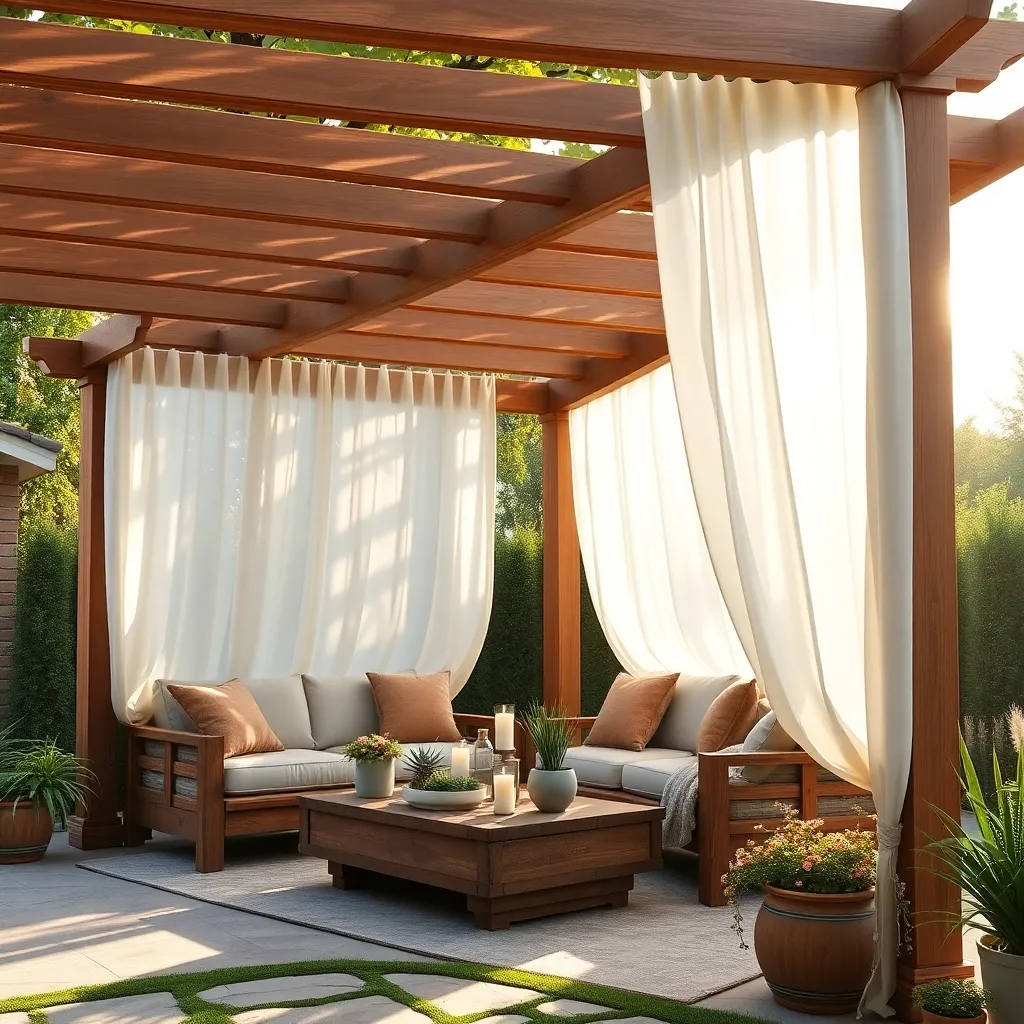
To enhance privacy and add a touch of elegance to your pergola, consider installing curtains. Opt for outdoor fabrics like Sunbrella or Olefin, which are specifically designed to withstand weather elements. These materials are UV-resistant and water-repellent, ensuring longevity and minimal maintenance. Basic installation involves attaching curtain rods or tension wires to the pergola structure; choose rust-resistant materials such as stainless steel or powder-coated aluminum for durability.
For a more sophisticated look, consider layering your curtains. Use a combination of sheer and opaque panels to control light and privacy levels throughout the day. Advanced DIYers can integrate curtain tracks that allow the curtains to open and close smoothly, providing a seamless transition between open-air and sheltered spaces. Ensure the length of the curtains is long enough to reach the ground for maximum coverage, typically requiring panels that are about 8 to 10 feet long, depending on the height of your pergola.
Innovative Lighting for Evening Use
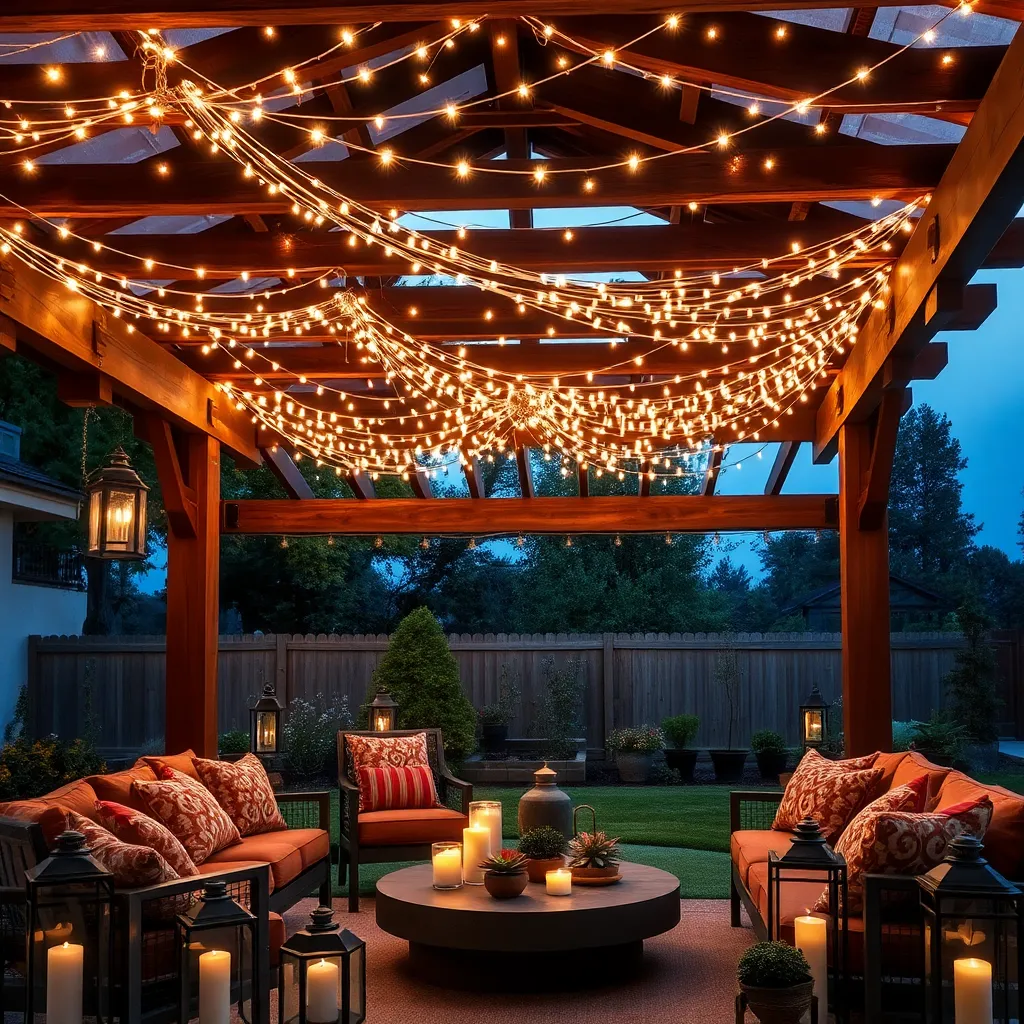
As the sun sets, innovative lighting can transform your pergola into a magical evening retreat. Consider installing string lights for a warm, inviting atmosphere. Opt for solar-powered options to save on energy costs and simplify installation. For a more sophisticated touch, integrate LED strip lights along the beams to highlight architectural details, providing both form and function. These lighting solutions can be easily attached using hooks or clips, making them accessible even for beginners.
For those seeking a more advanced installation, consider incorporating recessed lighting or lantern-style fixtures. Recessed lights can be installed directly into pergola beams, offering a sleek, modern look without obstructing the view. Lanterns, on the other hand, add a touch of classic elegance and can be hung at different heights to create visual interest. When choosing materials, select weather-resistant options like powder-coated metal or treated wood to ensure longevity. These thoughtful lighting choices will not only extend your outdoor enjoyment but also enhance the overall ambiance.
Eco-Friendly Pergola Design Options
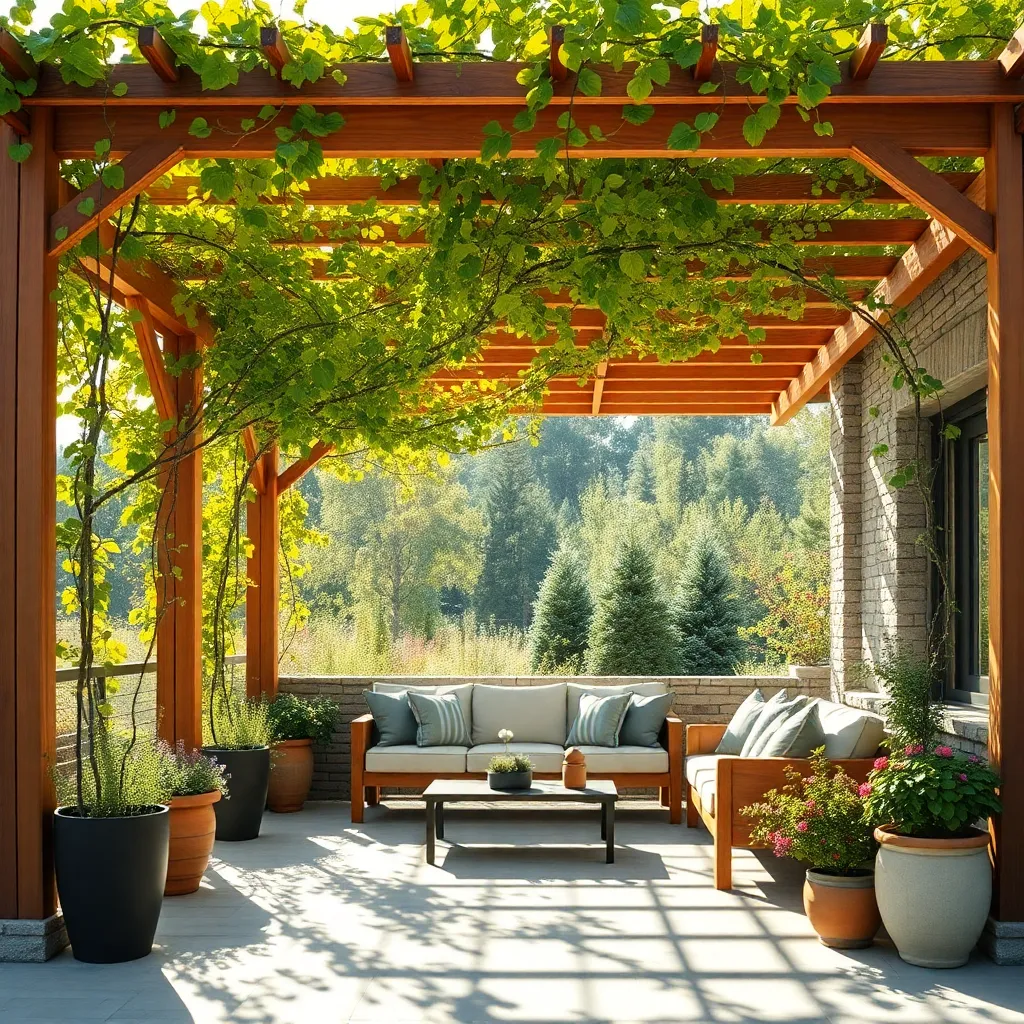
Consider using sustainable materials like bamboo or reclaimed wood to craft an eco-friendly pergola that blends seamlessly into your backyard oasis. These materials are not only renewable but also add a rustic charm to your outdoor space. For a simple design, aim for a structure roughly 8×12 feet, which provides adequate shade without overwhelming the area. Beginners can start with a basic rectangular frame, while experienced DIYers might incorporate lattice panels for added privacy and support for climbing plants.
To enhance the eco-friendliness, install a green roof by covering the top with drought-resistant plants, which aids in insulation and rainwater absorption. Opt for native plants that thrive in your climate to reduce water usage and maintenance. If you’re up for a challenge, consider integrating solar panels into the design to power outdoor lighting or small appliances. This not only increases the functionality of your pergola but also emphasizes sustainable living practices in your home environment.
Maximizing Space in Small Yards

To maximize space in small yards, consider a pergola design that utilizes vertical elements for added functionality. Installing shelves or hanging planters can transform your pergola into a vibrant vertical garden, making use of limited ground space. Opt for materials like lightweight aluminum or pressure-treated wood to ensure your structure is both durable and easy to maintain, which is ideal for compact areas.
Another effective strategy is to incorporate multi-functional features into your pergola design. For instance, integrating a bench with storage underneath can provide seating while keeping garden tools out of sight. Use a retractable canopy to offer adjustable shade, allowing you to adapt the space for different weather conditions. By employing these thoughtful design elements, even the smallest yard can become a versatile and inviting outdoor retreat.
Creating a Cozy Outdoor Retreat

Creating a cozy outdoor retreat with a pergola involves a few thoughtful design choices that enhance comfort and functionality. Start by selecting the right materials; pressure-treated wood or weather-resistant aluminum are excellent for durability and low maintenance. To add warmth and charm, consider incorporating natural elements like climbing plants or bamboo screens for added privacy. For beginners, a simple pergola kit can provide a straightforward assembly process, while more experienced DIYers might opt for custom designs with integrated seating or built-in planters.
Ambiance is key to a cozy outdoor retreat, so don’t overlook the importance of lighting and accessories. Install soft, ambient lighting such as solar-powered string lights or lanterns to create a welcoming atmosphere after sunset. To further personalize your space, add weather-resistant cushions and throws for comfort, and consider a small outdoor rug to define the area. Advanced enthusiasts can experiment with installing retractable canopies for adjustable shade, allowing for year-round use. These enhancements make your pergola not just a shade structure, but a true extension of your home.
Mixing Materials for Unique Designs
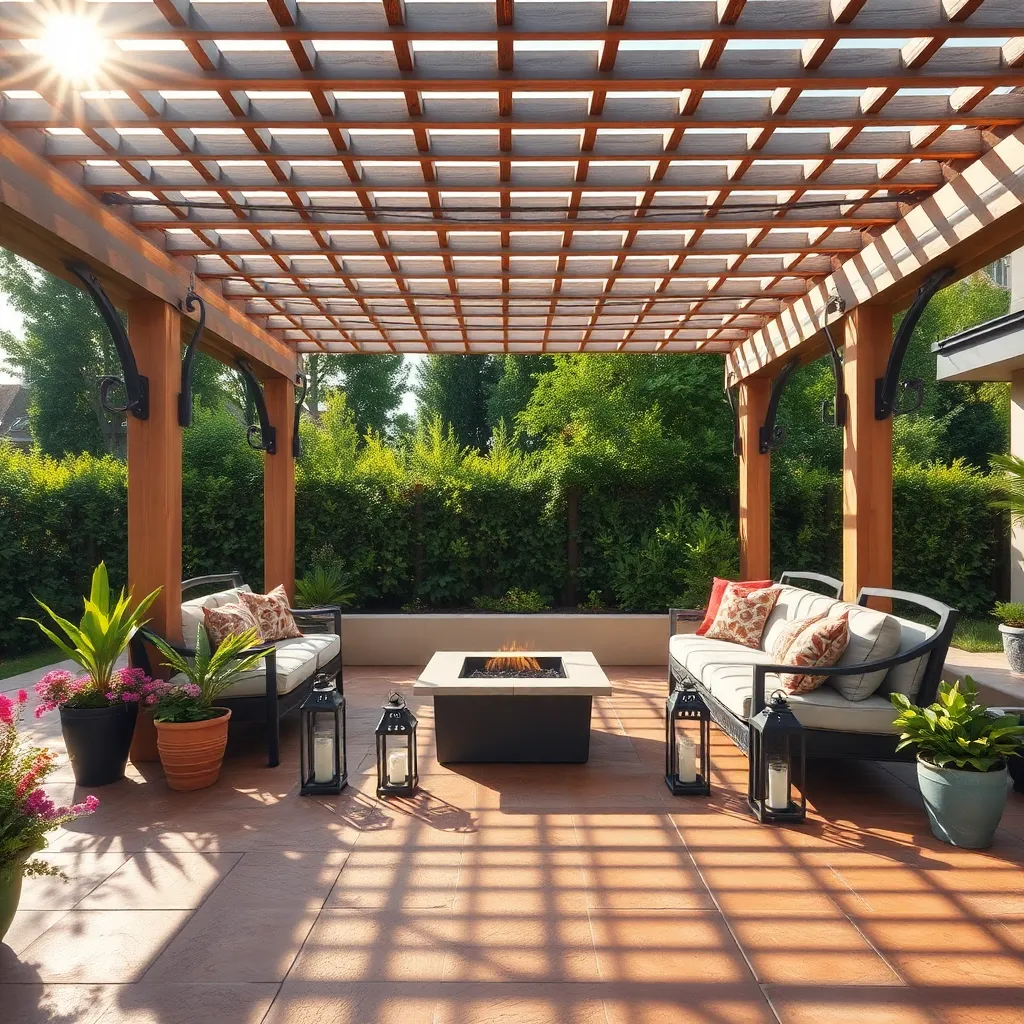
Exploring the combination of different materials can transform a standard pergola into a stunning focal point in your backyard. For a modern twist, consider using a mix of wood and metal. For instance, pairing cedar beams with steel or aluminum supports creates a striking contrast while ensuring durability. Beginners can start with a simple wooden frame and add metal brackets for stability, while more advanced builders might incorporate decorative metal elements like laser-cut panels to enhance visual interest.
To achieve a cohesive design, consider how the materials interact with your existing outdoor elements. Combining materials like stone and wood can add texture and warmth. Try using stone columns to support a wooden roof for a rustic yet elegant look. Remember to seal wooden components, especially if using untreated wood, to protect against weathering. Meanwhile, advanced DIY enthusiasts can experiment with adjustable louvered roofs, integrating metal or polycarbonate panels for added versatility in light control and protection. By mixing materials, you can create a pergola that not only provides shade and privacy but also complements and elevates your entire outdoor space.
DIY Pergola Projects for Beginners
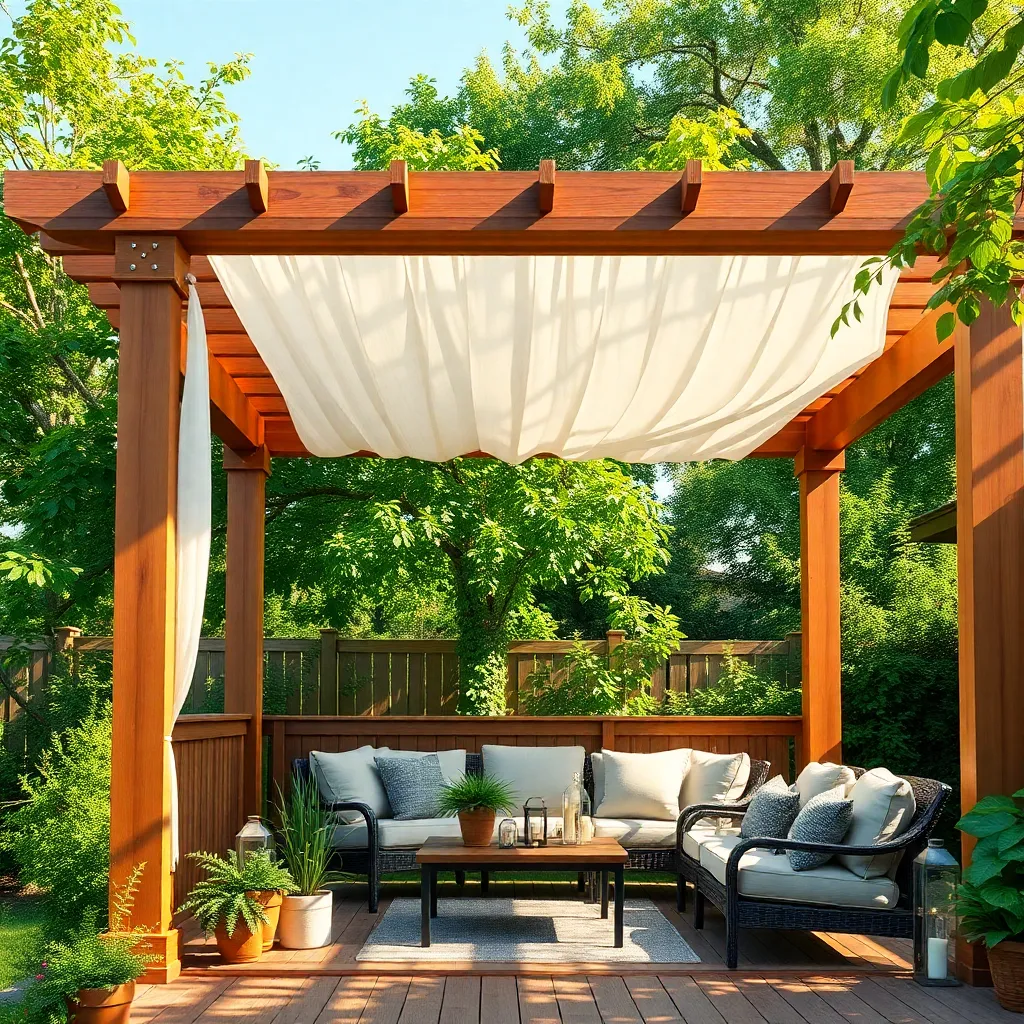
Building a pergola can be a rewarding DIY project that adds both shade and style to your backyard. For beginners, consider using pressure-treated wood or cedar, which are durable and easy to work with. Start with a simple design: a basic rectangular frame using 2×6 lumber for the support beams and 4×4 posts for the structure. Ensure the dimensions fit your space, typically around 8×10 feet, and anchor the posts securely in concrete for stability. This straightforward approach allows you to create a functional and attractive outdoor feature without needing advanced carpentry skills.
For those ready to add a bit more flair, consider incorporating decorative elements like lattice panels or climbing plants to enhance privacy and aesthetics. Use galvanized steel brackets for a stylish look and extra durability, especially in areas with challenging weather conditions. If you’re comfortable with a drill and saw, adding a slight arch to the beams can give your pergola an elegant touch. Remember to seal and stain the wood to protect against the elements and extend its lifespan. With these enhancements, your DIY pergola can become a standout feature that transforms your backyard into a cozy retreat.
Conclusion: Creating Beautiful Outdoor Spaces
In exploring these 15 pergola designs for backyard shade and privacy, we’ve uncovered valuable parallels that can enhance the landscape of your relationships. From the sturdy foundation of trust to the elegant arches of effective communication, each design element mirrors a key relationship concept. We’ve discussed the importance of creating safe spaces (both literal and emotional), the art of balancing independence and intimacy, and the power of adaptability as seen in adjustable pergola features. We’ve also touched on the need for nurturing growth, much like climbing vines on a pergola, and the beauty of unique expressions that make every relationship special.
As your next actionable step, choose one relationship concept from these designs to focus on this week. Whether it’s strengthening communication or fostering a nurturing environment, small changes can lead to lasting impact.
Don’t forget to save or bookmark this article as a handy reference guide. With continuous reflection and application of these insights, you’re well on your way to building not just a backyard oasis, but a thriving relationship. Remember, just like these pergolas, your relationship can provide shelter and beauty, standing strong through all seasons. Embrace these learnings and watch your relationships flourish.
